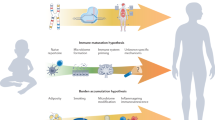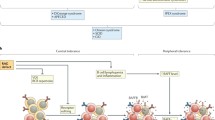Abstract
Many conditions can cause or be associated with arthritis in childhood. The authors of this paper will review the situations in which underlying immunodeficiency or defective regulation of lymphocyte homeostasis must be suspected, and discuss, for some of these diseases, the genetic bases and pathogenesis. In the second part of this article, the authors will focus on other diseases that can cause arthritis in childhood, often with other symptoms, and for which evidence of an association with genetic abnormalities has been recently discovered. Finally, the authors will discuss the implications of recent findings regarding the role of some genes as causing or modulating factors in juvenile idiopathic arthritis and related disorders, as well as observations made in adults and in animal models of inflammation and autoimmunity.
Similar content being viewed by others
References and Recommended Reading
Lindegren ML, Steinberg S, Byers RH, Jr: Epidemiology of HIV/AIDS in children. Pediatr Clin North Am 2000, 47:1–20.
Berman A, Cahn P, Perez H, et al.: Human immunodeficiency virus infection associated arthritis: clinical characteristics. J Rheumatol 1999, 26:1158–1162.
Medina-Rodriguez F, Guzman C, Jara LJ, et al.: Rheumatic manifestations in human immunodeficiency virus positive and negative individuals: a study of 2 populations with similar risk factors. J Rheumatol 1993, 20:1880–1884.
Mueller BU, Pizzo PA: Malignancies in pediatric AIDS. Curr Opin Pediatr 1996, 8:45–49.
Conley ME, Cooper MD: Genetic basis of abnormal B cell development. Curr Opin Immunol 1998, 10:399–406.
Ochs HD, Smith CI: X-linked agammaglobulinemia: a clinical and molecular analysis. Medicine (Baltimore) 1996, 75:287–299.
Franz A, Webster AD, Furr PM, Taylor-Robinson D: Mycoplasmal arthritis in patients with primary immunoglobulin deficiency: clinical features and outcome in 18 patients. Br J Rheumatol 1997, 36:661–668.
Liese JG, Wintergerst U, Tympner KD, Belohradsky BH: High- vs low-dose immunoglobulin therapy in the long-term treatment of X-linked agammaglobulinemia. Am J Dis Child 1992, 146:335–339.
Palacios Poggio G, Cisterna D, Freire MC, Cello J: RT-nested PCR for the detection of enterovirus in biological samples from patients with suspected enteroviral infections. Rev Argent Microbiol 2000, 32:165–172.
Rotbart HA, Webster AD: Treatment of potentially lifethreatening enterovirus infections with pleconaril. Clin Infect Dis 2001, 32:228–235.
Revy P, Muto T, Levy Y, et al.: Activation-induced cytidine deaminase (AID) deficiency causes the autosomal recessive form of the Hyper-IgM syndrome (HIGM2). Cell 2000, 102:565–575.
Sibilia J, Durandy A, Schaeverbeke T, Fermand JP:Hyper-IgM syndrome associated with rheumatoid arthritis: report of RA in a patient with primary impaired CD40 pathway. Br J Rheumatol 1996, 35:282–284.
Cunningham-Rundles C:Clinical and immunologic studies of common variable immunodeficiency. Curr Opin Pediatr 1994, 6:676–681.
Fischer A:Primary immunodeficiency diseases: an experimental model for molecular medicine. Lancet 2001, 357:1863–1869. A review that outlines the information provided by the study of primary immunodeficiencies.
Cavazzana-Calvo M, Hacein-Bey S, de Saint Basile G, et al.: Gene therapy of human severe combined immunodeficiency (SCID)-X1 disease. Science 2000, 288:669–672.
DiSanto JP, Bonnefoy JY, Gauchat JF, et al.: CD40 ligand mutations in x-linked immunodeficiency with hyper-IgM. Nature 1993, 361:541–543.
Cunningham CK, Bonville CA, Ochs HD, et al.: Enteroviral meningoencephalitis as a complication of X-linked hyper IgM syndrome. J Pediatr 1999, 134:584–588.
Levy J, Espanol-Boren T, Thomas C, et al.: Clinical spectrum of X-linked hyper-IgM syndrome. J Pediatr 1997, 131:47–54.
Klein C, Lisowska-Grospierre B, LeDeist F, et al.: Major histocompatibility complex class II deficiency: clinical manifestations, immunologic features, and outcome. J Pediatr 1993, 123:921–928.
Mullen CA, Anderson KD, Blaese RM: Splenectomy and/or bone marrow transplantation in the management of the Wiskott-Aldrich syndrome: long-term follow-up of 62 cases. Blood 1993, 82:2961–2966.
Rotman G, Shiloh Y: ATM: from gene to function. Hum Mol Genet 1998, 7:1555–1563.
Casanova JL, Abel L: Genetic dissection of immunity to mycobacteria: the human model. Annu Rev Immunol 2002, 20:581–620. An extensive review of the spectrum of genetic conditions that may cause susceptibility to Bacille-Calmette Guèrin and environmental Mycobacterium or to more virulent Mycobacterium such as Mycobacterium tuberculosis or Mycobacterium leprae.
Berthet F, Le Deist F, Duliege AM, et al.:Clinical consequences and treatment of primary immunodeficiency syndromes characterized by functional T and B lymphocyte anomalies (combined immune deficiency). Pediatrics 1994, 93:265–270.
Fischer A, Rieux-Laucat F, Le Deist F:Autoimmune lymph oproliferative syndromes (ALPS): models for the study of peripheral tolerance. Rev Immunogenet 2000, 2:52–60. Addresses the mechanisms and consequences of genetic diseases that have been recently recognized, and are characterized by with impaired lymphocyte death by apoptosis.
Le Deist F, Emile JF, Rieux-Laucat F, et al.: Clinical, immunological, and pathological consequences of Fas-deficient conditions. Lancet 1996, 348:719–723.
Dufourcq-Lagelouse R, Pastural E, Barrat FJ, et al.:Genetic basis of hemophagocytic lymphohistiocytosis syndrome. Int J Mol Med 1999, 4:127–133.
de Saint Basile G, Fischer A: The role of cytotoxicity in lymphocyte homeostasis. Curr Opin Immunol 2001, 13:549–554.
Stephan JL, Kone-Paut I, Galambrun C, et al.: Reactive haemophagocytic syndrome in children with inflammatory disorders: a retrospective study of 24 patients. Rheumatology 2001, 40:1285–1292.
Stepp SE, Dufourcq-Lagelouse R, le Deist F, et al.:Perforin gene defects in familial hemophagocytic lymphohistiocytosis. Science 1999, 286:1957–1959.
Sayos J, Wu C, Morra M, et al.:The X-linked lymphoproliferative- disease gene product SAP regulates signals induced through the co-receptor SLAM. Nature 1998, 395:462–469.
Dale DC, Person RE, Bolyard AA, et al.: Mutations in the gene encoding neutrophil elastase in congenital and cyclic neutropenia. Blood 2000, 96:2317–2322.
Segal BH, Leto TL, Gallin JI, et al.: Genetic, biochemical, and clinical features of chronic granulomatous disease. Medicine (Baltimore) 2000, 79:170–200.
Winkelstein JA, Marino MC, Johnston RB, Jr, et al.: Chronic granulomatous disease: report on a national registry of 368 patients. Medicine (Baltimore) 2000, 79:155–169.
Mouy R, Veber F, Blanche S, et al.: Long-term itraconazole prophylaxis against Aspergillus infections in thirty-two patients with chronic granulomatous disease. J Pediatr 1994, 125:998–1003.
Pickering MC, Botto M, Taylor PR, et al.:Systemic lupus erythematosus, complement deficiency, and apoptosis. Adv Immunol 2000, 76:227–324. These two reviews [35••,36••] address the role of complement in inflammation and autoimmunity, and also in susceptibility to infections in Mark Walport’s review. Pickering’s review is almost exhaustive in listing the complement disorders that may be associated with systemic lupus erythematosus and other inflammatory features in humans and animals. It also discusses in detail the hypothetical underlying mechanisms.
Walport MJ:Complement: second of two parts. N Engl J Med 2001, 344:1140–1144. These two reviews [35••,36••] address the role of complement in inflammation and autoimmunity, and also in susceptibility to infections in Mark Walport’s review. Pickering’s review is almost exhaustive in listing the complement disorders that may be associated with systemic lupus erythematosus and other inflammatory features in humans and animals. It also discusses in detail the hypothetical underlying mechanisms.
Mullighan CG, Marshall SE, Welsh KI: Mannose binding lectin polymorphisms are associated with early age of disease onset and autoimmunity in common variable immunodeficiency. Scand J Immunol 2000, 51:111–122.
Neth O, Hann I, Turner MW, Klein NJ: Deficiency of mannose-binding lectin and burden of infection in children with malignancy: a prospective study. Lancet 2001, 358:614–618.
Mitchell DA, Pickering MC, Warren J, et al.: C1q deficiency and autoimmunity: the effects of genetic background on disease expression. J Immunol 2002, 168:2538–2543.
Drenth JP, van der Meer JW:Hereditary periodic fever. N Engl J Med 2001, 345:1748–1757. A comprehensive revue focusing on familial Mediterranean fever, hyper-IgD syndrome, and TNF-receptor-associated periodic syndrome.
McDermott MF, Aksentijevich I, Galon J, et al.:Germline mutations in the extracellular domains of the 55 kDa TNF receptor, TNFR1, define a family of dominantly inherited autoinflammatory syndromes. Cell 1999, 97:133–144. The description of the molecular basis and the redefinition of a disease that may cause arthritis in childhood.
Hugot JP, Chamaillard M, Zouali H, et al.:Association of NOD2 leucine-rich repeat variants with susceptibility to Crohn’s disease. Nature 2001, 411:599–603.
Miceli-Richard C, Lesage S, Rybojad M, et al.: CARD15 mutations in Blau syndrome. Nat Genet 2001, 29:19–20.
Hoffman H, Mueller J, Broide D, et al.: Mutation of a new gene encoding a putative pyrin-like protein causes familial cold auto-inflammatory syndrome and Muckle-Wells syndrome. Nature Genet 2001, 29:301–305.
Beutler B:Autoimmunity and apoptosis: the Crohn’s connection. Immunity 2001, 15:5–14. An excellent review of the putative mechanisms by which molecules involved in cell death pathways may cause inflammatory diseases such as Crohn’s disease or familial Mediterranean fever.
Prieur AM, Griscelli C, Lampert F, et al.:A chronic, infantile, neurological, cutaneous and articular (CINCA) syndrome: a specific entity analysed in 30 patients. Scand J Rheumatol Suppl 1987, 66:57–68.
Feldmann J, Prieur AM, Quartier P, et al.: Chronic infantile neurological cutaneous and articular syndrome is caused by mutations in CIAS1, a gene highly expressed in polymorphonuclear cells and chondrocytes. Am J Hum Genet 2002, 71:198–203.
Chalom EC, Ross J, Athreya BH: Syndromes and arthritis. Rheum Dis Clin North Am 1997, 23:709–727.
Petty RE, Southwood TR, Baum J, et al.: Revision of the proposed classification criteria for juvenile idiopathic arthritis: Durban, 1997. J Rheumatol 1998, 25:1991–1994.
Albert ED, Scholz S:Juvenile arthritis: genetic update. Baillieres Clin Rheumatol 1998, 12:209–218.
Keul R, Heinrich PC, Muller-Newen G, et al.: A possible role for soluble IL-6 receptor in the pathogenesis of systemic onset juvenile chronic arthritis. Cytokine 1998, 10:729–734.
Date Y, Seki N, Kamizono S, et al.: Identification of a genetic risk factor for systemic juvenile rheumatoid arthritis in the 5’-flanking region of the TNFalpha gene and HLA genes. Arthritis Rheum 1999, 42:2577–2582.
Woo P:Cytokine polymorphisms and inflammation. Clin Exp Rheumatol 2000, 18:767–771.
Crawley E, Kon S, Woo P: Hereditary predisposition to low interleukin-10 production in children with extended oligoarticular juvenile idiopathic arthritis. Rheumatology (Oxford) 2001, 40:574–578. A demonstration that the inheritance of IL-10 polymorphisms associated with low production of this anti-inflammatory cytokine is associated with a more severe outcome of oligoarticular-onset juvenile idiopathic arthritis, the most common form of noninfectious arthritis in childhood. Preliminary experiments of gene therapy with IL-10 in an animal model of arthritis have been published by the same team.
McDowell TL, Symons JA, Ploski R, et al.:A genetic association between juvenile rheumatoid arthritis and a novel interleukin- 1 alpha polymorphism. Arthritis Rheum 1995, 38:221–228.
Wedderburn LR, Robinson N, Patel A, et al.:Selective recruitment of polarized T cells expressing CCR5 and CXCR3 to the inflamed joints of children with juvenile idiopathic arthritis. Arthritis Rheum 2000, 43:765–774.
Matsumoto I, Maccioni M, Lee DM, et al.:How antibodies to a ubiquitous cytoplasmic enzyme may provoke jointspecific autoimmune disease. Nat Immunol 2002, 3:360–365. This paper shows the most recent findings of Mathys and Benoist’s team with a mouse model of rheumatoid arthritis. These authors previously shown that arthritis in the K/BxN mouse model results from pathogenic immunoglobulins that recognize an ubiquitous glycolytic enzyme, glucose-6-phosphate isomerase (GPI), and that a functional alternative complement pathway was required for disease expression. They here show by immunohistology extracellular accumulation of GPI on the lining of the articular cavity in normal mice and that these GPI deposits are amplified and localized with IgG and C3 complement in arthritic mice and in humans with rheumatoid arthritis. Their hypothesis is that the expression of the disease on the cartilage is because of the absence of cellular inhibitors of the alternative pathway at this level. These findings are in favor of a model in which adaptive and innate immunity interact in causing arthritis.
Author information
Authors and Affiliations
Rights and permissions
About this article
Cite this article
Quartier, P., Prieur, A.M. Immunodeficiency and genetic conditions that cause arthritis in childhood. Curr Rheumatol Rep 4, 483–493 (2002). https://doi.org/10.1007/s11926-002-0054-5
Issue Date:
DOI: https://doi.org/10.1007/s11926-002-0054-5




